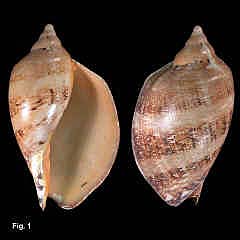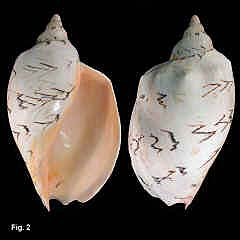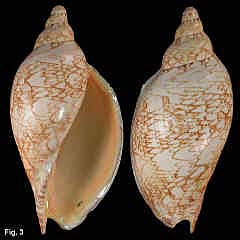|
|
|
|
|
Cymbiola magnifica (Gebauer, 1802) Description: Shell large, light to heavy in weight; apex blunt. Whorls rounded or shouldered, with or without nodules on the shoulder; early whorls smooth, later whorls usually with axial growth lines. Columella with 4 strong plaits; outer lip smooth. In the Sydney form, background colour fawn, with 3 or 4 spiral bands on the body whorl, containing axial and zigzag brown lines with triangular lighter areas superimposed and irregular brown splashes below the suture. Columella and aperture pale orange. Size: Adult shells 160-361 mm in length, typically about 250 mm. Distribution: Endemic to Australia; Capricorn Channel, off Rockhampton, Queensland, to Gabo Is, Victoria. Habitat: From the low intertidal down to 229 m. Commonly taken off Sydney by fishing trawlers in about 60 metres, and has been seen by divers in 10-50 metres. This species was once common in Sydney Harbour and Botany Bay, as the following extract from Angas' 1847 list of shells from Port Jackson records:
This species is now less commonly seen by scuba divers around Sydney and in southern NSW. It has been reported (Deas 1970) at depths of 16-26 metres buried in sand, crawling over sponge covered rocks and laying eggs. The eggs are attached to rocks or to solid substrates under the sand. The eggs are arranged into towers, each being quite firm, and could easily be mistaken for a plastic container of some sort. A photo of the egg mass is given by Wilson & Gillett (1971, p. 79) Remarks: Specimens from Sydney are light in weight without shoulder nodules, as in Fig. 1. A form with high spire from 60 fathoms (110 m) was named Cymbiolena magnifica altispira Mayblom, 1951, but the species shows continuous variation, and this does not justify subspecies status. Heavy weight, nodulose shells (Fig.2) are recorded from Sydney northwards, but appear to be more common in northern NSW and southern Queensland. A slender, lightweight form with pinkish colouration is recorded from the Capricorn Channel, central Queensland (Fig. 3). Fig. 1 Between Long Reef and Terrigal, NSW, in 30 fathoms (55 m) (DLB3504) Fig. 2 Off Brunswick Heads, NSW, in 70 m (DLB3917) Fig. 3 Off Swain Reefs, Queensland, in 125 fathoms (229 m) (DLB3913)
|


